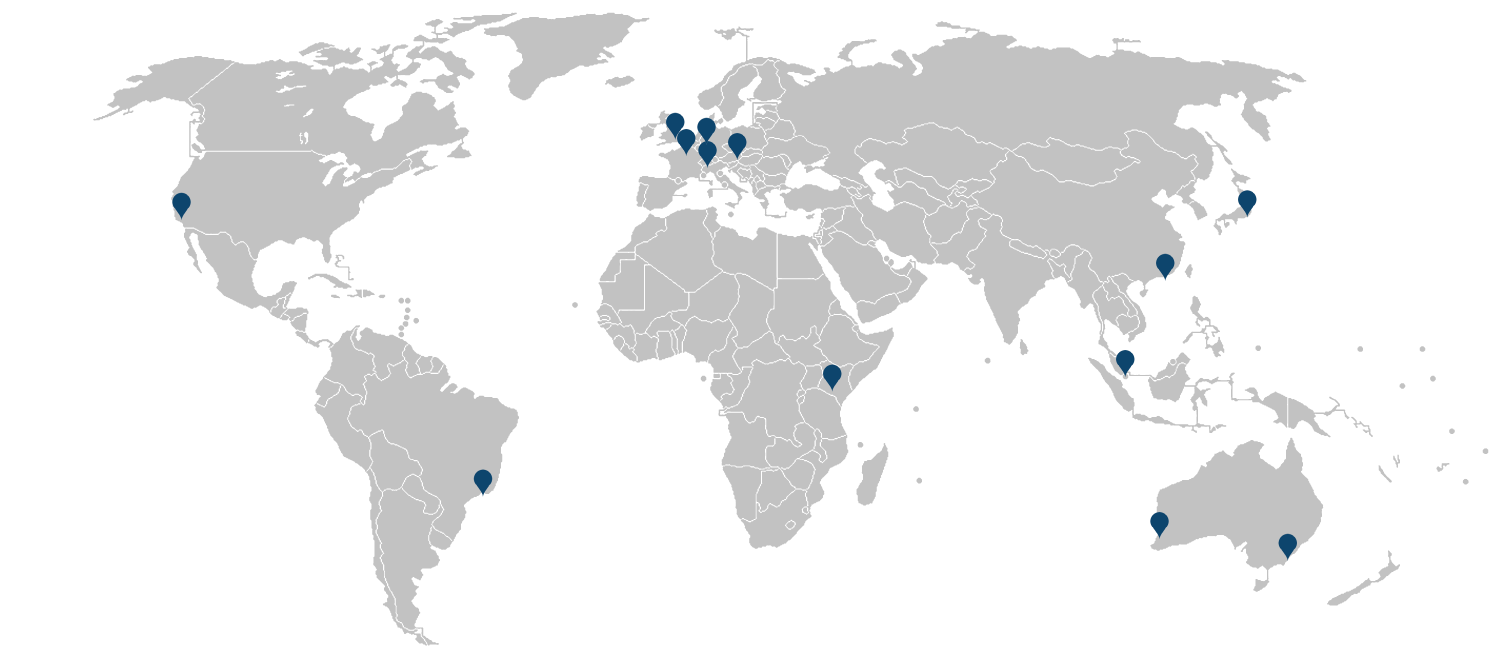A comprehensive call on central banks, supervision, and greening the financial system.
A comprehensive call on central banks, supervision, and greening the financial system.
Released in March 2019, the first call for proposals covered a comprehensive range of key research questions linked to the NGFS’s work program: i) microprudential, ii) macrofinancial, iii) scaling up green finance, and iv) cross-cutting issues. We received 28 proposals and funded 11 projects carried out by 36 researchers affiliated with 21 institutions.
Researcher locations

Downloads
Funded projects:
The stochastic impact of extreme weather events
In this project, we assess the impact of abnormal weather shocks on the global macroeconomy. Extreme weather events are random in size and location. We use stochastic trials to generate a distribution of weather shocks across the world and use NiGEM, a large macroeconometric model, to quantify the impact of these shocks on the macroeconomy. NiGEM links countries through trade and non-trade channels, and as such, a shock that impacts a single country or region will reverberate to other parts of the world. Our project captures the direct and the indirect impact of extreme climate events. Our analysis shows that extreme weather events cause economic volatility and that spillover effects magnify these events. We show that international spillover effects from trade and financial markets are important transmission channels, particularly for small open economies that are densely populated.
Our research has implications for at least two areas of central bank policy. The most proximate area of intervention is through the stress-testing framework where financial institutions should, in our view, disclose the risks posed by extreme weather events. Central banks can also adjust capital buffers to specifically account for assets that are exposed to such events and intervene in a more granular way using lending metrics such as the loan-to-value ratio. Second, where possible, the central banks can adjust the haircut imposed on the collateral that it accepts in its monetary policy refinancing operations by taking into account the financial risk posed by extreme weather events.
Show LessThe Effects of Mandatory Environmental, Social and Governance (ESG) Disclosure Around the World
In recent years, due to the dramatic increase in demand for ESG information to prompt sustainable growth, many countries and jurisdictions have issued regulations that mandate firms and financial institutions disclose their ESG situations and activities. But what are the real impacts of such mandatory ESG disclosure regulations on financial markets? We address this question by examining the financial stability of firms in 44 countries around the world over a sample period of 2000 to 2017.
To assess the stability of a firm, we measure the volatility of equity return and the likelihood of stock price crashes. Using multivariate regressions, we find equity return volatility is lower after mandatory ESG disclosure, and within this, systematic and idiosyncratic volatility are also significantly lower. We find stock price crash risk declines after the enforcement of mandatory ESG disclosure.
Our findings support calls for mandatory introduction of ESG disclosure requirements. In particular, stock exchanges should increase their ESG disclosure policies, as we show that mandatory disclosure improves the information environment. Moreover, our findings on financial stability are of interest to central banks and the enactment of mandatory ESG disclosure enhances the stability of the financial market by improving the ESG informational environment.
Show LessEnvironmental and Social Risk Management in Brazilian Banking: From an Environmental and Social Management Structure to Climate Scenario Analysis Development
The Central Bank of Brazil is taking encouraging steps for greening the country’s financial system. In 2014, the Brazilian National Monetary Council issued Resolution 4327, a principle-based resolution that required all Brazilian financial institutions to develop an Environment and Sustainability (E&S) management system with a comprehensive scope.
Three years later, Resolution 4557 was published, requiring risk management and structure for capital management of Brazil’s financial institutions, and in 2020, the Central Bank of Brazil joined the NGFS. In this study, we assess and benchmark the impacts of the Central Bank of Brazil’s Environmental and Social Risk Management policy by conducting interviews with Brazilian large- and medium-sized public, private, and development financial institutions. Central Bank of Brazil staff were also interviewed to gain clearer understanding that what kind of methodologies, tools, and practices would be better to assess financial institutions based on Brazilian Monetary Council (CMN) Resolutions 4327 and 4557.
Based upon our findings, we developed a self-assessment tool that will provide a checklist to help banks grasp the concepts behind the principles-based approach of the national E&S regulatory framework. We found Tropicalisation of international benchmarking from oversight bodies and market players (mainly those related to Taskforce on Climate-Related Financial Disclosures recommendations) is a way to improve E&S risk management process in Brazil (and potentially in other Latin American countries). Similarly, since 2020, high-level management engagement has enabled the Central Bank of Brazil to begin a better integration of E&S and climate issues into its regulation and supervision.
Show LessLow-carbon Transitions and Systemic Financial Risk
The transition to a low-carbon economy has been cited by policymakers as a potential driver of systemic risk that could lead to financial instability and negative macroeconomic outcomes. Most notably, Mark Carney’s ‘Tragedy of the Horizons’ speech warned of the potential of a transition-driven ‘Minsky moment’ whereby a disorderly process leads to a sudden collapse in asset prices.
We identify the channels through which a transition shock could lead to a systemic disruption. These include the downward repricing of carbon-intensive (or green) assets and a reduction in emissions-intensive production. We outline the approaches developed by existing studies to assess systemic risk, including the tracking of transition risk indicators such as bank exposure to emissions-intensive sectors, stress-testing frameworks, and network modelling approaches.
There is still much uncertainty on how to best measure the level of systemic risk posed by the transition, and therefore the size of this risk. Paradoxically, the realisation of systemic risks is more likely when the source of risk is not well understood. It is therefore important to consider the possible channels and work on their potential implications.
Show LessThe Role of Monetary Policy Under a Low-carbon Transition
We assess the implications for monetary policy action under a zero-carbon transition. Via a more stringent climate policy, the transition can result in both demand- and supply-side shocks. We seek to provide insights on the potential monetary policy responses to a climate policy shock by modelling the economic impacts using the multi-country, multi-sector model of the global economy, G-cubed. We draw on literature to define robust rules and we will consider rules that are uniform across regions, as well as differing rules in order to better replicate real-world monetary policy responses.
Our results suggest that a carbon tax consistent with 2° C of warming leads to a clear monetary policy trade-off, with higher inflation and a negative output gap. For the majority of countries, the impact on inflation outweighs that on output growth in the short term, whereas in the long term, the impact on output growth dominates, leading to a reduction in policy rates. The policy rate remains permanently lower once the shock has dissipated, suggesting that a persistent tax on carbon will lead to lower potential output and a lower neutral interest rate. Such a large tax on carbon would need to be accompanied by a large increase in productivity to offset the impact on potential output and long-term interest rates.
The shocks required to achieve ambitious targets lead to large negative impacts on emissions-intensive sectors. It’s difficult to assess how the transition to low-carbon energy sources will occur whilst also capturing the impacts on the rest of the economy.
Show LessClimate-related Financial Policy in a World of Radical Uncertainty: Toward a Precautionary Approach
Climate- and environment-related financial risks, both transition and physical, are characterised by radical uncertainty. This means conventional backward-looking probabilistic financial risk modelling is not fit for purpose in dealing with this uncertainty. While scenario analysis and stress testing to some extent recognise the uncertainty problem, they remain based on assumptions that are subject to significant uncertainty and do not sufficiently justify action in the short term, despite widespread recognition of the risks posed by inaction.
To address this lack of certainty, we have proposed the adoption of a new policy framework, the Precautionary Financial Policy (PFP) approach, to deal with the financial stability risks. This framework draws on two well established concepts: first, the ‘precautionary principle’ commonly adopted in environmental management policies to avoid passing certain thresholds, and second, modern macroprudential policy. PFP justifies fully integrating climate- and environment-related financial risks into financial policy, including both prudential and monetary policy frameworks. This helps to justify preventative actions now in order to mitigate the potentially catastrophic financial and economic damages created by climate change, and shape financial markets in a clear direction toward a preferred net-zero carbon future.
In terms of implementation, we propose the comprehensive integration of climate risk into capital adequacy requirements, monetary policy operations (including asset purchases and collateral criteria), quantitative credit controls and credit guidance, and the enhancement of financial system resilience. Policymakers adopting a precautionary approach should be aware of the likely short-term trade-off between efficiency and resilience, and likely resistance from market actors with shorter-term time horizons. There is a need to ‘learn by doing’ in this new environment.
Show LessOutputs
Central Banks’ Mandate in Green Credit Guidance: Beyond Prudential Regulation
The success of the Paris Agreement in enhancing the implementation of the U.N. Framework Convention on Climate Change and strengthening the global response to climate change in part owes to the integration of finance considerations. A legally binding document ratified by 187 parties, Article 2.1c of the agreement stipulates financial flows must be made consistent with a pathway toward low greenhouse gas emissions and climate-resilient development, and Article 9 sets out provision of financial resources. While financial flows directed toward climate change mitigation and adaptation are increasing, they remain significantly below those required under the Paris Agreement. This points to the need to leverage private sector finance in order to mitigate this funding gap.
This research assesses the potential role for central banks in implementing green credit guidance for commercial banks to mobilise the much-needed climate finance. Given the enormity of the green financing gap, central banks arguably have a role to play in redirecting private sector capital flows from high-carbon sectors to low-carbon sectors. We critically assess the various objections against green credit guidance by central banks and argue for a promotional role. We collect and analyse primary data through key stakeholder interviews at select central and commercial banks and supplement the findings through document analysis of banks’ financial reports and other relevant academic literature. The empirical findings highlight the concerns and views of the affected stakeholders.
Show LessPrudential instruments to scale up green finance: simulating the impact of green prudential regulations in an agent-based macro-financial model
The existing financial regulatory framework made notable progress in detecting, assessing, and containing systemic risks. However, a closer investigation of existing prudential instruments shows that several regulations under Basel III contain an intrinsic ‘carbon bias’ that creates barriers to aligning the financial sector with sustainable transition roadmaps. In particular, on the one hand, existing capital and liquidity regulations underestimate the risks related to so-called ‘green assets’ and potentially undermine the resilience of the financial system. On the other hand, they limit the bank capital available for green assets and favour dirty assets.
By considering the current state of the art, we highlight the lack of a comprehensive framework that is needed to analyse the impact of green prudential regulations. Thus, our research project aims to build such a framework and study how prudential regulations could deal with risks to financial stability arising from climate change. By building on theoretical research we have published in the past, this project aims to develop a tool to assess the implications of the implementation of different green prudential instruments under different macrofinancial scenarios. We will resort to the agent-based modelling approach (to build up a macrofinancial model) populated by a heterogeneous production sector, heterogeneous consumers, a banking sector, and a central bank.
This research will help in understanding, on the one hand, whether climate-related macroprudential tools lead either to market distortions or financial instability. On the other hand, it could assist in detecting which are the main factors that hinder or contribute to the effectiveness of such instruments.
Show LessAssessing forward-looking climate risks in investors’ portfolios: from theory to practice
Climate-related financial risk is characterised by endogeneity and deep uncertainty. The inadequacy of standard financial risk approaches to deal with these dimensions is a challenge for a smooth transition to a low-carbon economy. Across the last five years, we have developed a stream of work addressing this issue using a framework for climate financial risk management under uncertainty. This framework has been applied to the analysis of climate risk of financial portfolios, in collaboration with financial supervisors.
With this project, we aim to mainstream such a framework in microprudential and macroprudential policies implemented by financial supervisors and financial institutions belonging to the NGFS. We have engaged with relevant NGFS stakeholders through bilateral meetings, focus groups, and international conferences to co-develop narratives related to two main questions:
- How can the available scientific knowledge on climate change mitigation be best applied to identify relevant scenarios of disorderly low-carbon transition?
- What are the implications of scenario selection for investor decisions and for financial stability?
We found there is great importance to foster central banks’ and financial regulators’ understanding about:
- Climate change mitigation scenarios (e.g., those co-developed and used by the NGFS), their limits and opportunities, and the conditions to use them to inform climate stress tests exercises;
- The endogeneity of climate-related financial risks in climate stress test; and
- The conditions for finance to be a driver or a barrier to the transition.
Outputs
Sovereign risk and climate change
We investigate how climate risks impact sovereign credit risk and debt sustainability and assess the implications from a financial regulation and central banking perspective. We address the following two sub-questions:
- Through which channels can climate-related risks affect sovereign risk and how important are their respective impacts?
- What are the regulatory and supervisory implications for financial supervisors and central banks?
First, we develop a conceptual framework that characterises the transmission channels between climate risk and sovereign risk, stressing the importance for financial regulators and central banks to integrate these risks into their operational frameworks in achieving their mandated objectives. Second, building on this conceptual work, we assess the climate-sovereign risk nexus for the 10 member countries of the Association of Southeast Asian Nations (ASEAN), a group that includes four NGFS members (Indonesia, Malaysia, Singapore, Thailand).
We find climate change can have a material impact on sovereign risk through direct and indirect effects on public finances. Furthermore, it raises the cost of capital of climate-vulnerable countries and threatens debt sustainability. All branches of government will have to address climate-related risks and must climate-proof their economies and public finances or potentially face an ever-worsening spiral of climate vulnerability and unsustainable debt burdens. Monetary and financial authorities will have to play crucial roles in analysing and mitigating macrofinancial risks. Our research provides insights into policy coordination between the central bank and government in order to optimise public debt management.
Show LessOutputs
Greening the Eurosystem Collateral Framework
The collateral framework of the Eurosystem is a crucial component of the eurozone financial system, since it determines the way by which commercial banks obtain central bank liquidity and affects the credit conditions facing the non-financial sector. However, in its existing form, it does not capture climate risks and is not conducive to the decarbonisation of EU economies. Our analysis shows that carbon-intensive sectors are overrepresented in the list of eligible corporate bonds: 59% of the eligible bonds have been issued by carbon-intensive sectors, while the contribution of these sectors to the EU gross value added and employment are 29% and 24%, respectively.
We investigate how the Eurosystem collateral framework can become climate-aligned using two different approaches. In the first, ‘climate footprint’ approach, haircuts and bond eligibility are adjusted based on the climate impact of bond issuers, which in our analysis is captured by using both backward-looking and forward-looking metrics. The second, ‘climate risk’ approach, relies on the use of the NGFS climate scenarios for estimating the financial effects of climate risks on bond issuers. For both approaches we explore several policy options and show the implications for the haircuts per sector, the haircut-adjusted outstanding amount of bonds and the weighted average carbon intensity of the list of eligible bonds. We also analyse the channels via which a climate-aligned collateral framework can affect the climate performance of companies. We show that the ‘climate footprint’ approach can be more conducive to decarbonisation compared to the ‘climate risk’ approach, without reducing the amount of corporate bonds that euro area banks can post as collateral.
Show Less
























